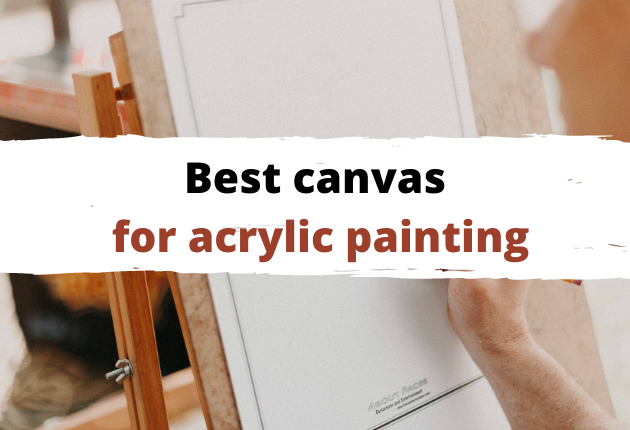The most popular support used for acrylics is a canvas – from stretched canvases to canvas pads and panels. Choosing the best canvas for acrylic painting is a key to the success and joy of painting.
But a bad-quality canvas can easily ruin all your art later and lead to cracks.
The best choice of canvas for beginners in acrylic painting is – a white pre-primed stretched canvas for showcase and hang your paintings and canvas panels or pads for practice.
The right canvas makes artists’ life so easier:
- paint adheres better to the primed surface of a canvas
- a painting on canvas will last longer
- it is portable and lightweight
- you can easily hang it even without framing
To choose your canvas to start with you should consider your budget and some small details about the types of canvases that I will cover in this post.
Besides canvas, there are more painting surfaces you can use for acrylics.
My Top choices upfront
TOP choice of the best canvas for acrylic painting for beginners – Blick Premiere Cotton Canvas – best quality with really unique properties and a very appealing price.
- Best cotton canvas roll – Utrecht Artists’ Acrylic-Primed Cotton Canvas Rolls
- Best stretched primed linen canvas –Masterpiece linen canvas
- Best raw linen canvas (unstretched, unprimed) – Blick Unprimed Belgian linen canvas
- Best canvas panel for acrylic painting practice – Mont Martre Canvas Panels
- Best canvas pad for acrylic – Canson XL Paper Pad
Tecnhically all these canvases, both primed and unprimed, will work with oil paint and any other mediums!
How to choose the best canvas for acrylic painting
Canvas is one of the oldest and most fantastically durable support for acrylic painting.
The history of art finds the word “canvas” is back in the 13-14th century – what else can prove to us better than this is the best option to start painting and to keep our masterpiece for centuries?
Nowadays, we can buy canvas in art supplies stores offline and online. Before buying, you need to be familiar with some factors that affect quality and price:
- the fabric of the canvas
- weight and weave
- depth of the edges
- format and shape
- stretching and supporting material
- priming
- and, obviously, your budget and preferences
You will easily find all the information on the canvas label or in the description online, it can look like this:

It would be nice if you can immediately make your choice after looking at this, so let’s get familiar with each factor. After reading this post you will definitely have NO issues with choosing your canvas.
1 – Fabric
The fabric is one of the keys to a great painting canvas. Acrylic paint should stick to it and the canvas should dry well, so the quality of the fabric is vital.
There are 4 types of canvas based on fabric: cotton duck, linen, jute, and synthetic canvases.
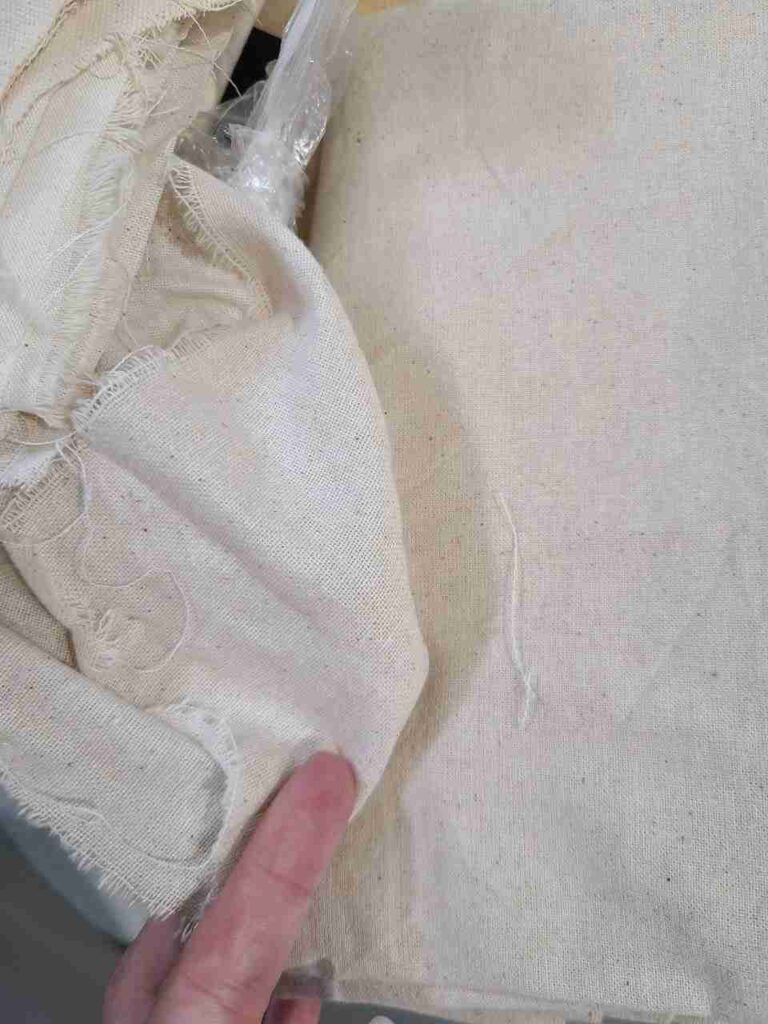
Linen fabric is easy to recognize, raw linen canvas is a dull brown, while cotton canvas will be white. Linen is made from natural fibers of the flax plant and contains natural oils that make it mold and mildew-resistant. It is considered the “top” of canvases.
Cotton canvases are made of cotton fibers and are THE MOST common and are used by most artists, especially beginners.
Synthetic canvases and jute are very rare to find and uncommon
4 Types of canvas for acrylic painting
| Factor | Cotton duck | Linen | Jute | Synthetic |
|---|---|---|---|---|
| Use | The MOST common *no ducks involved! Doek means cloth in Dutch. | Common among Pros | Uncommon * from Jute plants | Uncommon * Polyester, Polyflax e.i. |
| Price | Cheap | Expensive | Expensive | Cheap |
| Pros | – Cheap – Easy to find and buy – Comes in a variety of weights and textures ranging – They are extremely common | – Unlikely to stretch or shrink – Mold and mildew resistant – Has a variety of weights and textures – Better quality than cotton | – a little bit rougher than the average linen – cheap – better than cotton – very durable | – can be water-resistant or even waterproof – great for outdoor – tightly interlaced and smooth with fine texture – stronger than Cotton Duck or Linen |
| Cons | – Could be loose – Can easily distort when stretched. | – Price – needs stronger stretcher bars – oil-primed linen can not be used with acrylics! | – uncommon – can be pricey | – uncommon – hard to buy – archival qualities aren’t studied yet |
| Brands | All popular brands | Blick, Masterpiece | SoHo | Winsen’s Canvases, Fredrix Blue Label |
Keep reading, I have a list of the Top Best cotton and linen canvases above. Or you can jump to that section right now. Click here.
2 – Weight and weave
Canvas comes in different weights and weaves.
The weight of the canvas refers to the fabric density and heaviness.
Weaving means that cotton or linen fabric threads were interlaced to form the canvas. But the difference is in how tight they are. Weave determines the texture of the canvas. The tighter the fabric is woven, the rougher the surface of the canvas will be. But it can also affect how heavy the canvas will be (but not always).
The terms ‘super fine’, ‘extra fine’, ‘fine’, ‘medium weave’, and ‘rough’ describe the texture of the weave.
The weight is measured in ounces per yard (oz x yrd). Unprimed canvas can be:
- light-weighted ± 5 oz (140 g). Can be smooth and almost has no texture. The weave is open, which means has some air holes and fine. This type is very easy to stretch and great for a light touch in painting. Not a good choice for a large painting.
- medium-weighted ± 8 oz (230 g);
- heavy-weighted ±10 oz (280 g) or more. Great for impasto and thicker paint application. Has a pronounced surface and tightly woven. Perfect for larger canvases and paintings.
Primed canvas will be heavier because its weight will include the primer (usually acid-free gesso)

You can smooth weave with gesso or use them as part of the texture of your future painting.
3 – Depth of the edges
The depth of the edges is how much will the painting stand out from the wall. The deeper the edges are, the easier it will be to hang the painting even without framing. In the canvas description, you will find it as depth or profile.
The depth of the edge can be:
- normal (traditional profile) ± 3/4″, 1½”
- deep edge (deep profile) ±1-3/8″- 1 5/8″, 2½” and 3″
In general, the narrower the edge is, the cheaper the canvas will be.
Most artists prefer deep edges because nowadays we don’t really like to frame the painting and with deep edges, we can just paint them and hang the painting on the wall. If you plan to frame your work, choose thin edges.
4 – Format and shape
No matter what type the canvas is, it could have diverse shapes (even three-dimensional) and formats. The standard formats are called landscape or portrait.
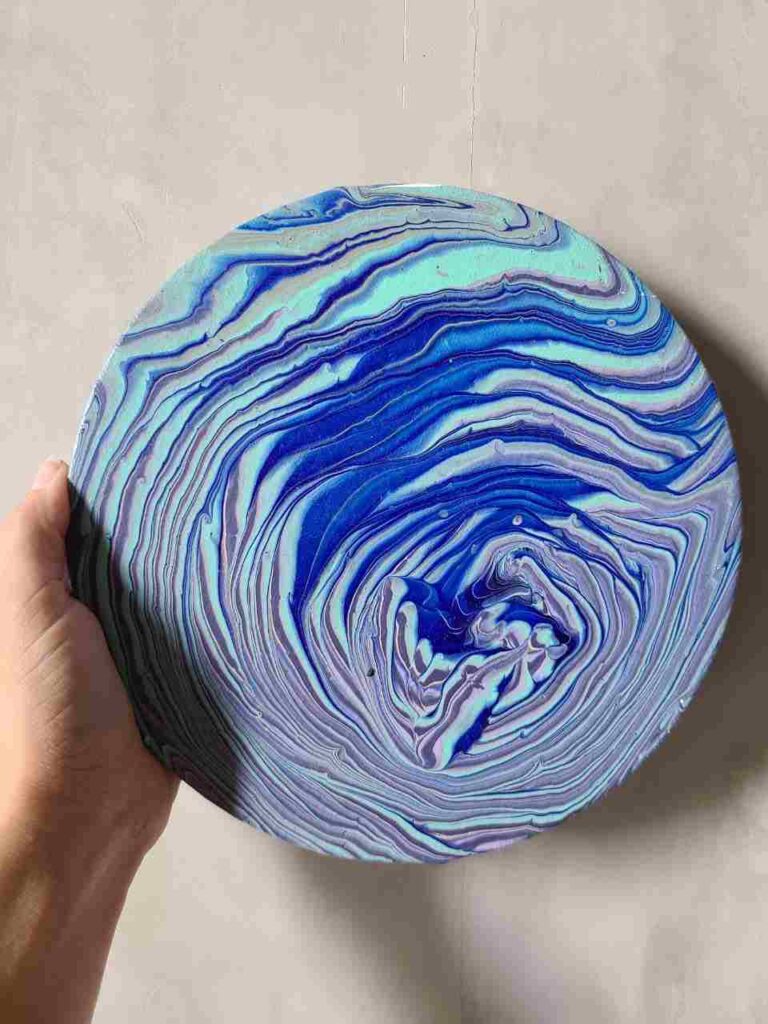
The most common shapes are:
- square,
- rectangular, and
- round. I love round canvases for pouring
- Great for interiors are also Half Round, Hexagon, and Triangle styles.
The choice of the shape and size is based only on your preferences and ideas!
I’m doing abstract art and I adore large canvases or even creating diptychs.
5 – Stretching and supporting material
Stretching is a very important step.
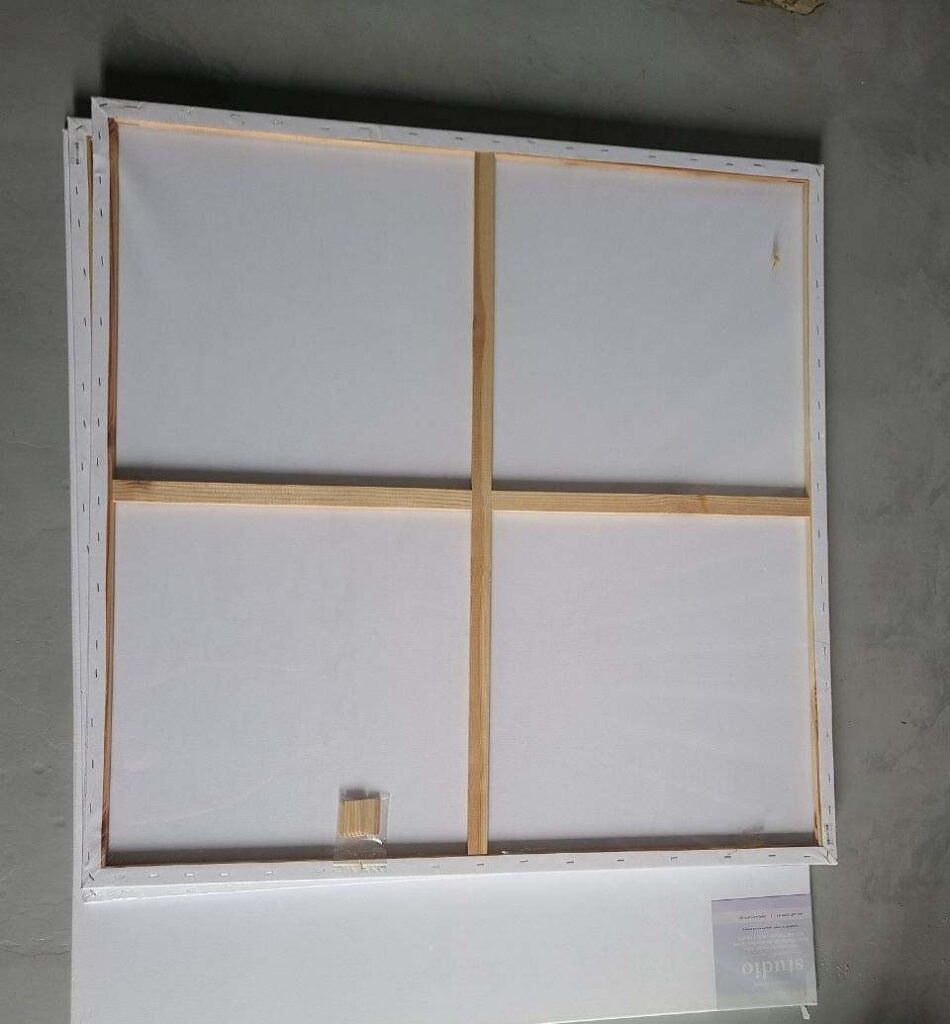
For beginners, it is easier and more recommended to buy well-known pre-stretched canvas, while pro artists can be very quick with stretching canvas by themselves.
Either way, canvases should be well stretched and secured to the stretcher bars.
The stretcher bars themselves should be high-quality.
Canvas can be stretched in some ways:
- side stapled (it means the fabric is stapled to the stretcher bars on the sides of the canvas). Nowadays almost none of the good brands do that. First of all, it is perceived as student-grade quality, second – no gallery will accept a painting on a side stapled canvas.
- gallery wrap canvas is the same as back-stapled. The most common and best choice. In this case, the corners of the fabric could be cut or just folded. If it is folded and you have large areas left, you can easily adjust the tension.
- splined on the back. This type of stretching can look nicer but it will be a pain in the ass to re-stretch it.
- sewn into books.

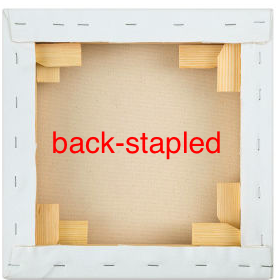
Stretcher bars are actually bars to what canvas is stapled. In general, they are made from kiln-dried pine. They should not be too thin, because it is the actual support of the canvas and future painting.
The stretcher bars are what give depth to your painting, which we discussed above.
Stay away from stretcher bars which are made with finger joint interlock wood connections, because they will fall apart over time and ruin your canvas.
Some pre-stretched canvases, especially large ones, can have additional bars across the canvas – a cross brace. Canvases larger than 20×24 should have at least one cross-bar, canvases larger than 30×30 – two.
Sometimes you can find wooden “keys” in your canvas wrap. It is an old way but still popular to tighten the canvas if it begins to sag. You can always buy them separately too. The keys will look like that:
Pro tip: if you buy a canvas in an art store, slightly press against the stretcher bar. If you see some indentations, this is not good quality.
Read also: How to Use Acrylic Paint On Canvas: 3 Easy Steps For Beginners
6 – Priming
Some canvases come already primed, but some are raw.
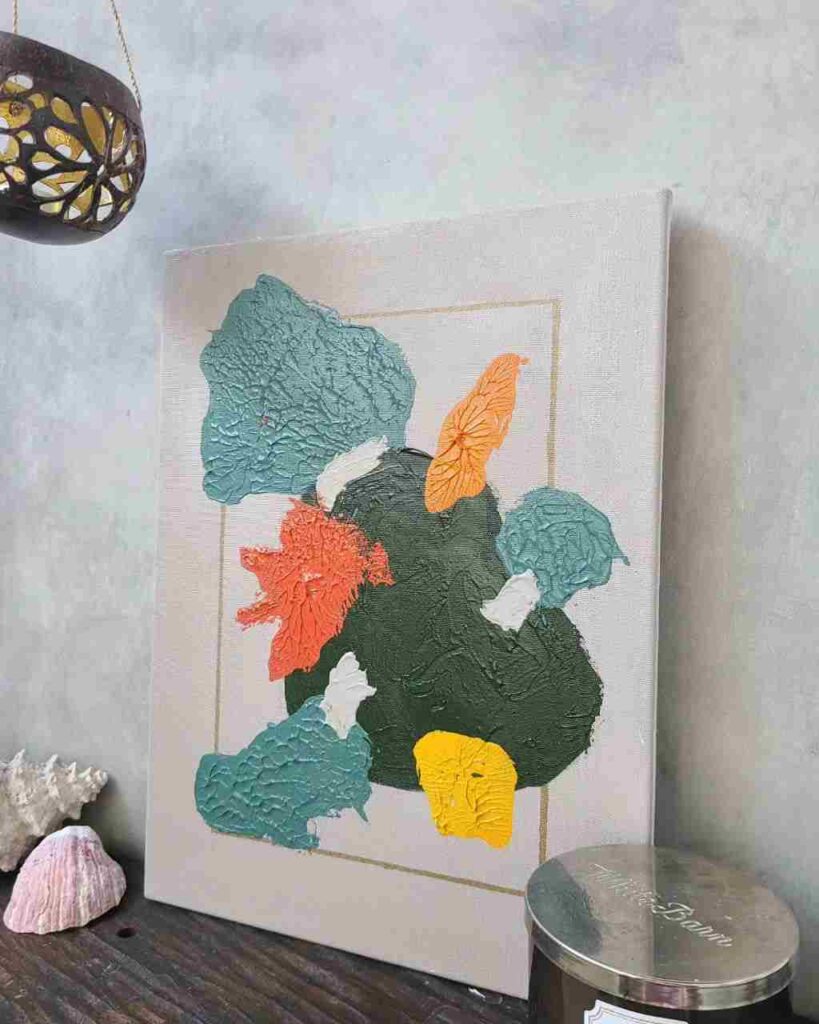
A beginner’s recommended way to go is to use pre-primed canvases.
But one day you can easily buy a raw one and learn how to prime it. On the other hand, I know that some modern abstract artists use raw canvases without priming.
But what else is important about priming is how many layers the manufacturer applied and what kind of gesso they used.
The best choice is the triple-primed canvas. Normally, brands use acid-free gesso, which means the surface is sealed, non-porous and smooth, and ready for painting. Some brands also use eco-friendly gesso.
Single or double-primed canvases are less popular and I assume that they are more like student-grade quality.
You can always apply another layer of gesso if you are not satisfied with how smooth the surface is. Make sure you follow the proper process.
7 – Price and preferences
You will be surprised that you can find really good quality for a very pleasant price. Still don’t ever make choice only based on price. Try different brands and canvases and makes notes.
For beginners, I recommend cotton pre-stretched and triple-primed canvases. I use them too and enjoy them.
Best canvas for acrylic paint for beginners – Blick Premiere Cotton Canvas

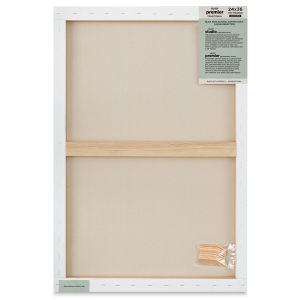
This is a real hand-made canvas for a very good price. For me, it is one of the best options on the market. An EXCELLENT choice for beginners with really unique features compared to all other canvases on the list.
PROS:
- maximum archival stability and durability
- handwoven
- triple primed with sanding in between layers
- affordable price
- you can re-stretch it: corners are uncut, keys are included
- depth: 1-1/2”, 2-3/8”, 7/8”
- 10-15 oz weight
- professional artist grade
- stretcher bars with warp-resistance and long-term stability
- two stretched options: Hand-Splined or Back-Stapled.
- Wide range of available sizes: from 4×4 to 36×48
- If you will buy them online at the official Blick Art Supplies store and in bulk, the price will be even better. Ex., Back-Stapled Traditional Profile Canvas 14×18 costs $9.45 per piece, but if you want to buy 5, you will pay $7.33 per piece.
CONS:
- Honestly, NONE!
Even if we’ve learned that linen canvas is of better quality, you will still find most artists and especially beginners using cotton canvas. They have great quality, and, most important, they are affordable. They probably don’t have the BEST quality, but when we just start painting, we will never see this tiny difference.
By the way, all canvas panels and pads are cotton-made. So, don’t be frustrated by the fact that linen fabric is better, all artists are still using cotton for diverse purposes.
Feel free to try cotton and linen, and always listen to yourself and rely on your experience.
Arteza Stretched White Canvas – Runner-up
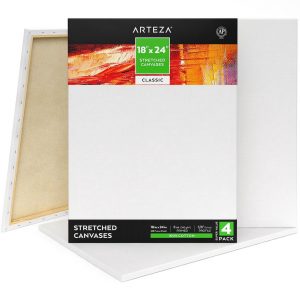

Arteza is slightly cheaper than Blick ($1-2 cheaper) but the quality is weaker – it is perceived as student-grade. Nothing wrong with it, Arteza’s stretched Classic canvases are still good for students, kids, and hobby artists, and they have more than 50 nice reviews on Arteza’s website.
It is 100% cotton, medium-weight (8 oz) canvas.
Arteza also offers stretched canvas primed with black gesso.
PROS:
- affordable price, even better if you buy in bulk
- pre-primed with cruelty-free, non-toxic, acid-free gesso
- pre-stretched on pine-wood support
- full refund if you are not satisfied with the quality
- good for students and hobby
- multi-pack option available: 28 canvases of different sizes: 6×6″, 8×8″, 10×10″, 12×12″ only for $39. Great deal.
CONS:
- Might be too rough texture for professional painters
- Primed with a single layer
US Art Supply Black Stretched Canvas

Sometimes it is easier to paint directly on the dark background without spending time painting it by yourself. Imagine a galaxy or night sky on this – it makes painting even more enjoyable.
It is a heavyweight (12 oz), 3/4″ Profile sized canvas
Not only this brand has Black canvas.
PROS:
- triple-primed
- affordable
- hand-stretched
- black background, but white color is also available
- sustainable wood for support
- good both for painting and pouring
CONS:
- I didn’t use this one but I’ve read some reviews about loosened canvas over time
Masterpiece Artist Canvas – Elite – Higher quality canvas for acrylic painting
If you are looking for something exclusive and highest quality, this is it. But with all of it, you will also get the highest price. Also, I realized that they are extremely hard to purchase and, in fact, can’t compete with cheaper competitors.
It is a 100% heavy cotton canvas with 1-1/2″ deep edges. It comes only in large sizes.
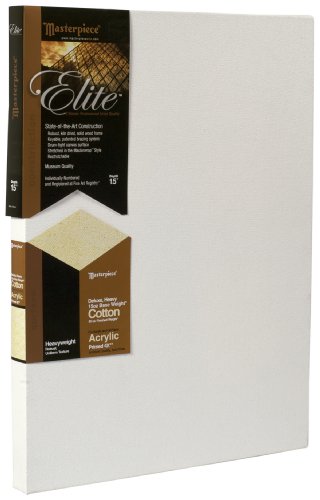
PROS:
- double primed with archival quality acrylic gesso.
- Double wide Cross Braces
- up to 50% tighter than other canvases due to their unique technology
- linen option is also available
CONS:
- price
- it is a really heavy and tough canvas
- only large sizes
- only double-primed!
Winsor & Newton Classic Cotton Canvas
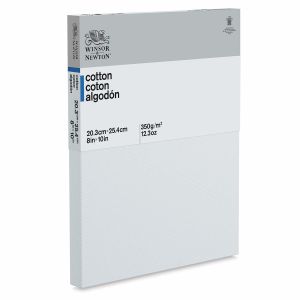

100%, medium-textured, fine, back-stapled canvases. It is a heavily weighted canvas (12.3 oz)
Sizes: from 6×6 to 30×40
PROS:
- archival gesso
- improved paint adhesion and color saturation
- kiln-dried fir and paulownia wood
- hand-stretched
- stretcher bars are rigorously tested for warp resistance.
- 2 options for depth: Traditional (3/4″) or Deep Edge (1-3/8″) profile
CONS:
- I’m not sure about how many layers of gesso they used
- not really cheap
Best Cotton Canvas in Roll
The best-primed cotton canvas in roll is Utrecht Artists’ Acrylic-Primed Cotton Canvas Rolls

Great choice due to its exceptional durability and paint adhesion.
PROS:
- triple primed with acrylic gesso
- 100% cotton
- great paint adhesion
- great workability
- great weight – 14 oz finished weight
CONS:
- only 2 sizes available: 60” × 6 yds and 84” × 6 yds
Prices are: $99.05 – $138.17
Best Raw Cotton Canvas
The best raw cotton canvas is Blick Cotton Canvas By the Yard
This canvas comes in the roll unprimed if you order 5 yards or less. If you order more than 6 yards it will come in a roll. This unique canvas has 4 weights available: 7, 10, 12, and 15 oz.
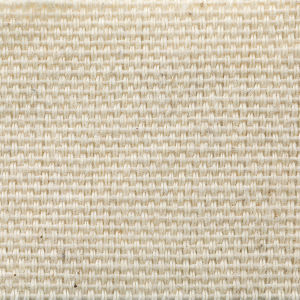
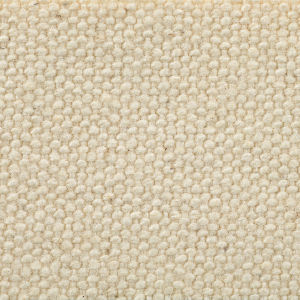

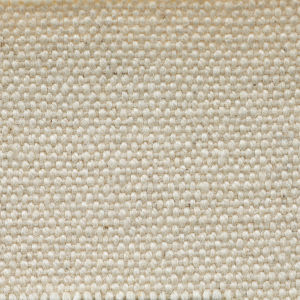
PROS:
- 4 weights are available: 7oz has a very fine texture, 10oz is good for detailed work, 12 and 15oz are for heavy applications
- different sizes available: 37.5″ x 1 yd, 48″ x 1 yd, 60″ x 1 yd, 63″ x 1 yd, 72″ x 1 yd, 84″ x 1 yd, 96″ x 1 yd
- unbleached
- natural
- very affordable, cheaper than alternatives
CONS:
- the longest continuous length will be based on inventory availability and may come in multiple cuts.
- the price depends on weight and size
- unprimed
Price is around 5-16 dollars per yard depending on weights.
Raw canvas in roll is cheaper but can cause a real headache for a beginner. If you buy canvas in roll or folded, it means that you already have an idea about how to stretch it.
If you don’t know yet how to do it and are not sure if you can make it the first time without loosening the canvas on the support, choose the pre-stretched canvas I listed above.
Another option is that you don’t want to stretch it at all and want to cut shapes and sizes as you like. In this case, you will be able to paint the floor and experiment.
Best Linen canvas For Acrylic Painting
Linen is known to have better quality than cotton. The best linen is Belgian linen.
The downside of the linen canvases is their price. They could be a nice work surface for professional artists, but they are too expensive to start with.
Masterpiece Artfix Acrylic Primed Linen Canvas is the best linen canvas for acrylic paint.
Masterpiece Artfix Acrylic Primed Linen Canvas
This linen canvas was primed 2 times – two coats of sizing, to seal the linen fabric and 2 coats of priming for best paint adhesion.
It is a gallery style canvas, with properly folded edges – it doesn’t get slack and edges are nice even for frameless display.
Sizes available: from 4×4 to 24×36
PROS:
- 2 options: Vincent Pro with 7/8″ profile and 5/16″ relief, and Monet Pro with 1-1/2″ profile and 1/2″ relief
- archival-quality Belgian linen
- double coats hand-primed
- heavy, 12 oz
- uncut selvage leaves a possibility to re-stretch
- excellent bracing system: canvas 16″ x 20″ and larger are cross-braced
CONS:
- doesn’t have really large sizes
- expensive, almost $18 for a 4×4 piece
Best Raw linen canvas
The best unprimed linen canvas for acrylic painting is Blick Unprimed Belgian linen canvas
Produced in Belgium with exclusive weave configurations. Pieces up to 6 yards long are shipped folded. Longer pieces are shipped in rolls.
Blick Linen canvas has some unique styles:
- Type 66J and Type 144 are smooth and tightly woven and great for portrait and detailed work,
- Type 185 and 135 are general-purpose high-quality canvases,
- Type 73D is an ideal midpoint texture between fine and medium, it is a great general-purpose type.
- Type 74D is extremely strong and has a double wave pattern.
- Type 215 and Type 79D are the types of choice for artists who work with texture.
- Style 200 is a style apart – it is a herringbone texture, the heaviest among all types.
PROS:
- Belgian linen
- Several styles (weights) and sizes available with unique characteristics
- Depending on the size sold from 1 yard
CONS:
- Styles are a bit confusing, it seems like there are too many of them
- Some styles are extremely expensive
canvas panels For Acrylic Painting
A canvas panel is a primed fabric glued to the board. The best option is when the canvas is wrapped around the edges of the archival or acid-free board and is glued to the board with archival glue.
It makes the panel rigid, with smooth textured support for painting. Panels come in white, black, or some other metallic color (uncommon).
Very cheap and low-quality canvas panels will not be wrapped around the edges.
Most of the panels are cotton canvas panels, but I will share with you some linen too.
Canvas panels are ideal for practicing and experimenting, for small painting and pouring works. They are quite impossible to frame.
The BEST Cotton Canvas panel is Mont Martre Canvas Panel
It is a great and affordable choice for beginners, it is not the best quality, but very well-made panels for acrylic painting or pouring when you start practicing.
Sizes available: 4×4, 5×7, 8×8, 8×10, 9×12, 11×14, 12×12, 12×16.
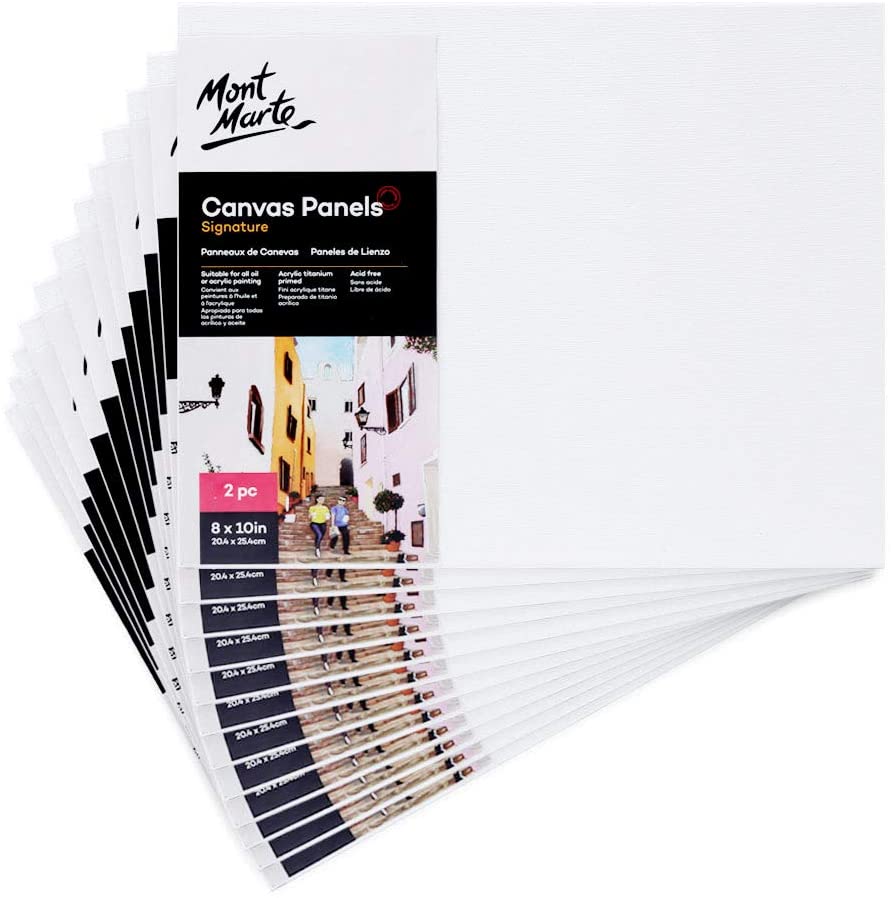
PROS:
- durable
- 100% unbleached pure cotton duck
- triple primed with 4oz acid-free acrylic titanium gesso
- Back-stapled and shrink-wrapped
- rank 4.7 on Amazon (2000+ reviews)
CONS:
- I haven’t discovered any, some reviews mentioned warping.
canvas pads For Acrylic Painting
A canvas pad is a sheet of spiral-bound primed canvas or canvas paper.
The canvas paper is simply heavy paper with a surface texture like canvas. Canvas sheets are real canvas.
The real canvas pads might last years, but not centuries. They are good for practicing and tests but not for showcasing your talent in Louvre.
They come in a few different sizes and are an affordable way to improve your painting skills.
Compared to canvas panels, canvas paper sheets are easy to frame.
As they are paper sheets be careful with the amount of water you use.
The BEST Canvas Pad for acrylic painting is Canson XL Paper Pad
I suggest buying on Blick as their Canson pads are much cheaper than on Amazon.
1 – Canson XL Paper Pad
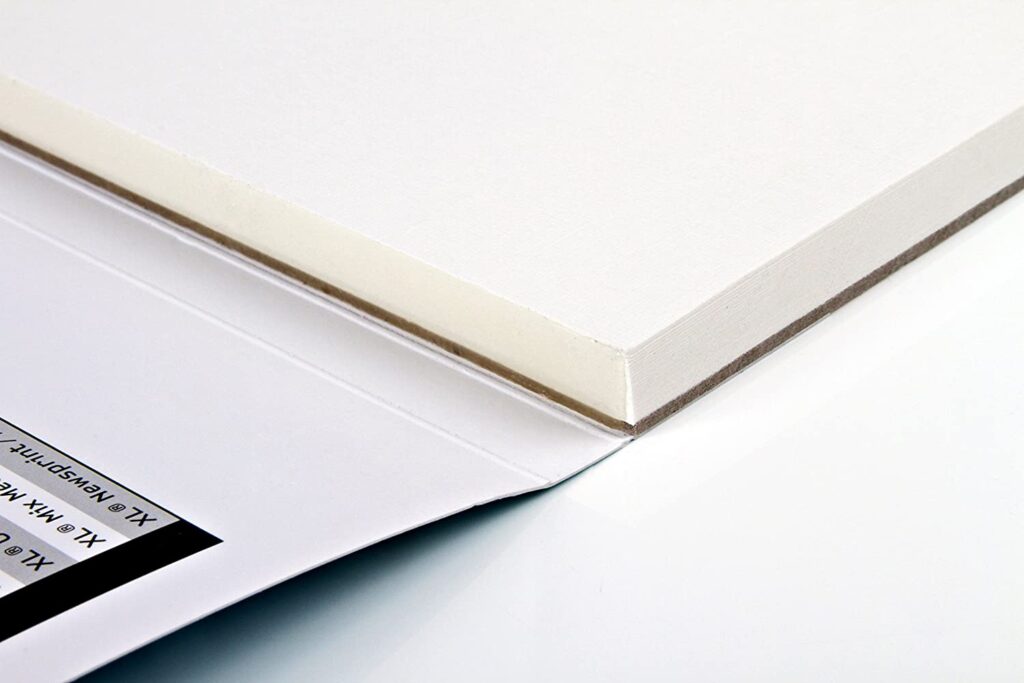

This paper pad is good for oil and acrylic, it is a bleed-proof, textured surface for painting.
Available sizes: 5.5×8.5, 9×12, 11×14.
PROS:
- 24 sheets of 136 lb/290 gsm acid-free paper in the pad. All alternatives offer 10 sheets in a pad
- French-made paper
- 4.8 based on 3500 reviews on Amazon
- extremely cheap: 9 dollars on blick and 14 on amazon, cheaper to buy on Blick
CONS:
- the whole concept of sheets in a book will not last long, eventually, they will fall apart
Tips for Choosing The Best Painting Canvas
To sum up, before buying a canvas answer these questions and you will buy the Best Canvas for Acrylic Painting for Beginners for YOU:
- what is your idea for the next painting? Is it better to have a small or a large canvas? What shape would be the best?
- do you know how to prime canvas? If no, choose pre-primed canvases, if yes – raw ones.
- buying a pre-primed canvas, choose the color, would you like to start on a white surface or you have an idea that needs to be done on a black primed canvas?
- will you frame your painting? If not, choose a canvas with thick edges.
- what is your budget? Cotton canvas is cheaper in general.
- will you use a stretched canvas or a roll? If you stretch your canvas yourself, you can buy a roll one, but you are just at the beginning of your artistic way, stick to stretched canvas.
- what is your level in painting? Beginner – stay with primed and stretched cotton canvases, cotton panels, and pads, intermediate – try linen stretched and primed canvases or raw canvas, pro – do whatever you want! Joking, do what feels right whatever your level is 😉
- if you buy a canvas panel, check what type of wrapping it has and the priming (at least double).
FAQ
What is the best type of canvas for acrylic painting?
The best canvas for acrylic painting for beginners is a primed cotton canvas. It saves you money and time on priming and you can directly paint on it. For Pros the best type of canvas is linen canvas but it is also quite expensive. Many artists love buying unprimed canvases and preparing them for painting in their special way.
What canvas do professional artists use?
Professional artists use high-quality linen and cotton canvases. They buy canvas in rolls and prime it with their own gesso to assure the best paint adhesion and results.
What is the best material for painting canvas?
There are two main materials for painting canvas: cotton and linen. Both are great, but cotton is cheaper than linen. Many craft shops sell cheap primed cotton canvases for beginners to practice and improve their skills. Linen is expensive thus only experienced artists can afford to buy and paint it.
What is the best brand of canvas for painting?
The best canvas brand for beginners and bulk purchases is Blick Premiere Cotton Canvas – affordable, primed, and of great quality! Masterpiece and Fredrix brands make beautiful and durable raw and primed canvases for professional and skilled artists.
On a side note, I also would like to say that I used sometimes such a cheap canvas for pouring and painting and it worked, but as you progress you can feel and see the difference.
With time I noticed how cheaper canvases can be more wobly, easy to break, the wooden frame is not good.
It is especially important for me when I work on a very large project.
What is your top choice for painting canvases?

Masha Eretnova, born in 1991, is a Buenos Aires-based certified teacher, artist, and member of the Professional Artist Association with 20+ years of personal painting journey.
She started painting and drawing very early and is now an international abstract artist and educator passionate about acrylic painting, gouache, and crafts.
Her works are part of international exhibitions and contests, including ArtlyMix (Brazil), Al-Tiba 9 (Spain), Exhibizone (Canada), Italy, and many more.
Besides her artistic pursuits, Masha holds a post-grad diploma in Teaching Film Photography and 2 music school diplomas: piano and opera singing.
Last update on 2024-04-23 / Affiliate links / Images from Amazon Product Advertising API
